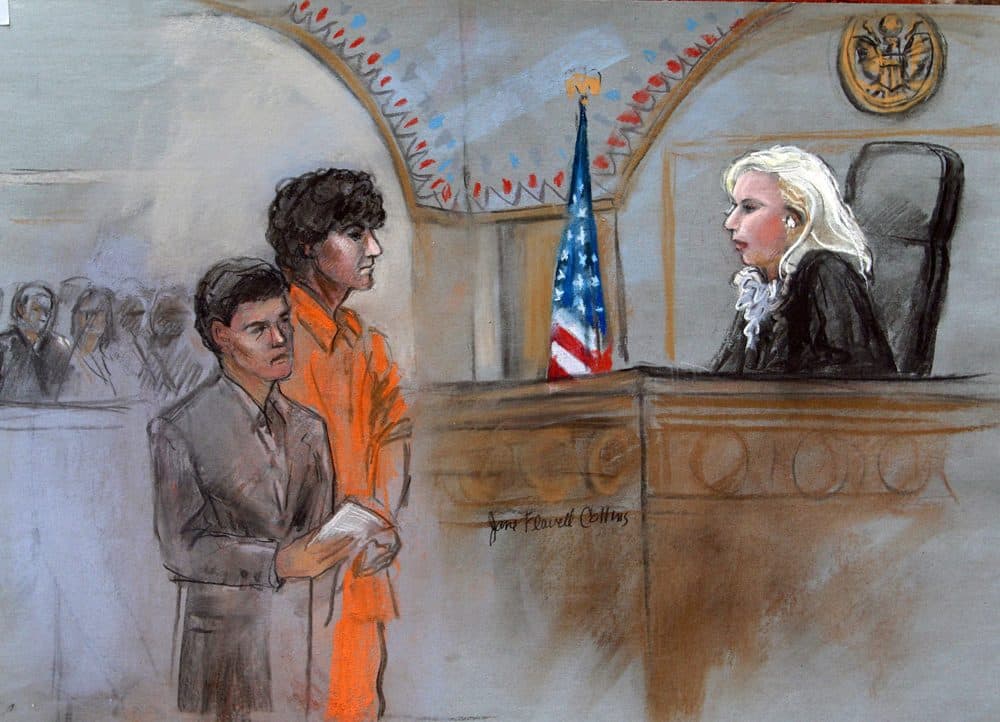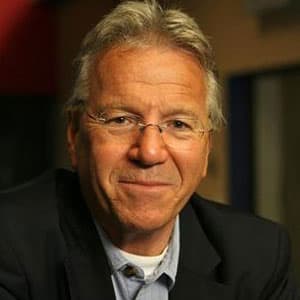Advertisement
High-Profile Cases Set For Boston Federal Court, But Still No Cameras Allowed

This story was co-reported with Massachusetts Lawyers Weekly. The MLW version is here.
BOSTON — One of the oldest principles of American law is that justice must be seen to be done. According to the U.S. Supreme Court, “justice must satisfy the appearance of justice.”
But when it comes to the appearance of judges, prosecutors, defendants and witnesses in criminal trials at federal court, that's a different matter. You cannot see or hear any of them unless you are there. That’s because judicial officials in Washington have long banned TV cameras, radio microphones and newspaper photographers from all U.S. district courts.
In the coming months, significant trials will take place in Boston’s federal courthouse. But only a few members of the public will get to see any of them.
'A Trial Is A Public Event'
“The courts don’t belong to the judges. ... They belong to the people who pay the taxes.”
Robert Barton, retired state Superior Court judge
You want a preview of what you are going to see and hear if you are not in the courtroom when Dzhokhar Tsarnaev goes on trial on charges of murdering four and injuring 270?
Put your hands over your ears and close your eyes. That’s it.
Retired state Superior Court Judge Robert Barton was on the bench some 35 years ago, when Massachusetts opened its courtrooms to cameras. He thinks the federal ban is "disgraceful."
"I've always said that the courts belong to the public," he said. "The courts don't belong to the judges, even in multimillion-dollar federal courthouses with magnificent lobbies. They belong to the people who pay the taxes."
Barton’s criticism of the “keep out” signs for cameras in federal court puts him in the company of a blue-ribbon assortment of judges — state and federal, current and former.
"I mean, they are living with a pillowcase over their head," Barton barked.
Advertisement
Consider the high-profile, high-impact trials uncoiling in Boston’s federal courthouse:
- The corruption trial of former Probation Commissioner John O’Brien is bringing dozens of state legislators and judges to the stand to answer how applicants got their jobs in state court.
- The Boston Marathon bombing has led to multiple indictments and individuals scheduled for trial, culminating this fall, when federal prosecutors seek the death penalty against the younger Tsarnaev brother.
- And a retrial (that the government is asking be scheduled in February) will determine whether to impose the death penalty on Gary Lee Sampson, already convicted of carjackings in which he murdered two people in 2001.
Yet a judicial system that promotes its openness will be closed to all but a few.
"What's interesting about the federal courts is that the security cameras are built into the walls," said Harvard law professor Nancy Gertner, who served as a federal judge for 17 years. "So the notion that this would be in any way intrusive of the proceeding ... is absurd."
Indeed, every one of the courtrooms has cameras and microphones capable of broadcasting. They actually did broadcast last year's James "Whitey" Bulger trial to overflow audiences in other courtrooms of the same building. New rules even allow reporters to tweet and blog from the courtroom. But record video and sound with your iPhone, and you're in trouble.
The critics are getting louder, though.
"You know what the Founding Fathers said about the trials and being open: They ought to be held in front of as many people as would choose to attend," said U.S. Sen. Charles Grassley, of Iowa.
For the last 13 years Grassley has been filing “sunshine in the courtroom” bills in the Senate. He’s the ranking Republican on the Judiciary Committee and wants cameras in courtrooms. Significantly, he’s in line to become chairman if the Democrats lose the Senate in November.
Grassley likes to quote a certain Supreme Court ruling. Grassley said, "Quote: 'A trial is a public event. And what transpires in a courtroom is public property.' " Unquote, and therefore: "It’s going to be more public property if it’s televised."
While he has not yet succeeded in pushing cameras into the courtrooms, Grassley's bills have pushed the U.S. Judicial Conference into initiating a pilot program here in Boston and elsewhere to test the effect of cameras in limited circumstances.
Alex Kozinski, chief judge of the U.S. Court of Appeals for the Ninth Circuit, advocates for cameras, but said things might change at the federal level "at a glacial pace."
Kozinski's court in California is one of two exceptions where cameras are welcome. That’s because he and his fellow Ninth Circuit judges voted to allow them inside in 1993 after the U.S. Judicial Conference gave that right to appeals courts (but not to district courts, which are the trial courts).
"At first our judges were very sort of apprehensive and nervous about it and worried that they would be portrayed out of context," he said. "But we have had a very good experience with it. It has been very informative to the public."
Kosinski says that cameras have effectively brought the Ninth Circuit court to the broad sweep of Montana, Guam, Alaska and Arizona. But other appeals courts in circuits across the country, including Boston, have resisted change. And none of the nation’s 94 district courts ever got the same right to allow cameras, so the broadcasting of criminal trials has been banned since 1946.
Secretive Supreme Court Sets The Tone
So where is the all the resistance coming from?
Mark Wolf, a senior federal judge in Boston, says the nation's highest court sets the tone from top down.
"The United States Supreme Court prohibits the broadcasting or recording in real time of its own proceedings," he said.
Listen to some members of the high court addressing the subject in Congress or other venues in recent years and you capture a sense of their opinion.
"There are some people who want to make us part of the national entertainment network," Justice Anthony Kennedy publicly complained in 2005 at the idea of televising Supreme Court proceedings.
“Not a chance,” said Justice Anthony Scalia in a 2012 C-SPAN interview. He said the news media would use camera coverage in a sensationalized and irresponsible fashion.
"Somehow when you see it live, an excerpt when you see it live, it has much greater impact," Scalia said. "I’m sure it will miseducate the American people, not educate them."
The subject often turns staid justices into tigers.
“I can tell you,” then-Justice David Souter said to a congressional committee in 1997, “the day you see a camera come into our courtroom, it's going to roll over my dead body."
On the issue of cameras, the famously divided court seems surprisingly united.
Here, Justice Kennedy beseeches a Senate committee in 2009 not to pass legislation that would televise Supreme Court proceedings: "Please, senator, don’t introduce into the dynamics that I have with my colleagues the temptation, the insidious temptation, to think that one of my colleagues is trying to get a soundbite for the television. We don’t want that."
Although the U.S. Judicial Conference technically makes the policy recommendations for the lower courts, observers say it takes its marching orders from the Supreme Court, and specifically from the chief justice, who chairs the conference.
"It would be interesting to know what governmental institutions people think function better now that they're on television," U.S. Supreme Court Chief Justice John Roberts said.
Judges and court personnel paint a picture of the high court as far removed from the everyday normality of camera coverage allowed by state courts since the 1980s. To every lawyer who makes oral argument before the court, one insider pointed out, the justices award a memento. It's a pen. "A quill pen."
Roberts says a three-year pilot project to study the effect of cameras in civil cases signals progress.
But this is hardly a “bold experiment," Judge Wolf said, because another three-year pilot program tested the same thing back in the early 1990s. The results were so clear — that cameras had a negligible effect, if any, on the administration of justice — that the pilot was ended after only two years, Wolf said.
But when proponents of cameras then recommended they be allowed into criminal and civil cases alike, the U.S. Judicial Conference emphatically said no.
"In fact, they did the opposite, without any empirical research or, as I'm told, any discussion or debate," Wolf said. "They adopted a policy directing the judicial councils to prohibit broadcasting in particular proceedings."
Gertner voices the common opinion that the pilot program has been designed to fail.
"What is it, almost 50 percent of state courts now have had cameras for the past 30 years with cases that are much more high profile, bloody, prurient interests of the public than anything that goes on in the federal courts?" she said. "And the republic still stands."
Michael Sullivan, who was U.S. attorney before Carmen Ortiz, practiced law in the trial system of Massachusetts when cameras were first introduced and later as Plymouth district attorney. “Quite candidly,” he said, “no one even notices the camera being in the courtroom. I’m confident that the same thing would actually happen in the federal system as well.”
We asked to speak with the Judicial Conference about its policies and reasons for opposing cameras in trial courts. But officials declined to make anyone available, saying they would feel more comfortable speaking after the pilot program ends, another year from now.
Grassley and the co-sponsors of his "sunshine in the courtroom" bill express confidence that federal trials will be broadcast someday. But so far quill pens hold sway over cameras.
This segment aired on May 30, 2014.
